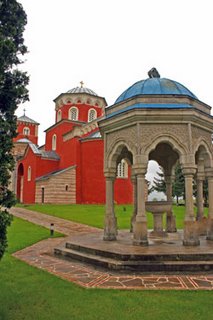With the rain still persisting, we began the drive towards our next destination – Studenica. The road followed the Western Morava and Ibar Rivers. Both were very high. Plastic bags clung to trees in the swollen river. Along a 20 km long scenic gorge created by the Western Morava River are over 10 tiny monasteries. Constructed mainly in the 15th and 16th centuries, these monasteries were located in more secluded places away from main roads and far away from Turkish towns. We briefly visited Vavedenje Monastery, located closer to the town of Čačak. Like most
 of these small monasteries, Vavedenje was very simple. The existing church structure was built in 1874 after the original one had been destroyed. No frescoes remained from the original structure, but the carved wooden altar is older.
of these small monasteries, Vavedenje was very simple. The existing church structure was built in 1874 after the original one had been destroyed. No frescoes remained from the original structure, but the carved wooden altar is older.Traveling once again through the remote, mountainous region, we reached Studenica. Established at the end of the 12th century, this monastery is one of Serbia’s greatest monasteries and is highly regarded by Orthodox Serbs. We entered through the imposing Western Gate, constructed of stone with a wooden pyramid roof.
In the small church known as King’s Church (built in 1314), a special Maundy Thursday service was taking place. The priest was chanting and waving incense. Many of the frescoes in the church were quite well-preserved. As in the Mileševa church, the fresco portraits portray realism rather than simply stylizing figures. I did not feel comfortable looking around very long during the service and quietly went outside.
 I took a tour around the exterior of the main church completed in 1191, known as the Church of Our Lady (or Church of the Holy Virgin). A prototype of the Raška School style, the architecture seamlessly blends Romanesque and Byzantine styles. The exterior is covered with polished white marble, unique in Serbian medieval architecture. The cupola is a red color, just like the King’s Church. My favorite architectural element is the 3-windowed apse. Framing the three narrow windows are carvings or elaborately sculptured leaves, figures, and mythological beasts. Carvings of a similar style could be found around one of the doors.
I took a tour around the exterior of the main church completed in 1191, known as the Church of Our Lady (or Church of the Holy Virgin). A prototype of the Raška School style, the architecture seamlessly blends Romanesque and Byzantine styles. The exterior is covered with polished white marble, unique in Serbian medieval architecture. The cupola is a red color, just like the King’s Church. My favorite architectural element is the 3-windowed apse. Framing the three narrow windows are carvings or elaborately sculptured leaves, figures, and mythological beasts. Carvings of a similar style could be found around one of the doors.Most of the original frescoes inside the Holy Virgin church were completed in 1209 and repainted in 1569. The Crucifixion fresco is especially splendid. Recent earthquakes (compounding previous ones) have raised questions of stability. Many of Studenica’s remaining treasures (what was left after repeated lootings) are now in a small museum on-site, but it was closed for the day. The dining hall was open for view. In one end was a large fireplace; in the other, a long table for the king and important leaders. The yellow residential quarters looked much newer than the church buildings, dating back to the 18th century. Bedding was hung over the window ledges, airing out even in the rainy weather.
I hope to go back to Studenica and take more photos and enjoy the ambience – hopefully with blue skies that make this UNESCO World Heritage site so captivating.
Žiča Monastery

Heading towards Kraljevo, we stopped at the Žiča Monastery. Constructed in 1209 and finished in 1217, this church is painted in a distinctive rusty red color. Here, a church service was also in progress. In the arched entryway, I could see a few frescoes. Sadly, most of the original frescoes were destroyed by Bulgarians in 1290 or later by Turks seeking to obliterate any depiction of the human image. On both sides of this entryway were round windows intricately carved out of stone. On the grounds was a beautiful domed baptistery, reconstructed from some of the original fragments.
Back to Belgrade
It was time to head back to Belgrade. The bus trip from Kraljevo took about 3 hours, but the time went by quickly due to the fascinating company of a college student from Poland. She also was visiting Serbia and Montenegro on her spring break. From the windows of the bus, I could see flooded fields. Back in Belgrade, the road next to the bus and train station was still flooded; I opted to take a taxi home. Despite the inclement weather, I enjoyed my trip to western Serbia. I hope to revisit some of the places with family and/or friends.
No comments:
Post a Comment